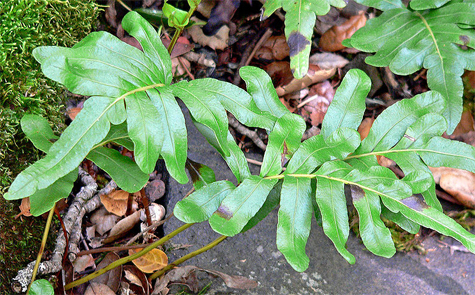|
Hardy Fern Home P. scouleri resources
All Ferns � Polypodiaceae �� Polypodium
�Other Genera
|
| Polypodium scouleri | ||
Coast polypody, Leathery polypody | ||
|
Etymology
John Scouler, an explorer with David Douglas in the Pacific Northwest
Description
Rhizome: creeping, branching, whitish waxy, stout, to 12 mm diameter, bland to slightly sweet-tasting, scales lanceolate, brown, sometimes lighter near margins.
Frond: 60 cm high by 27 cm wide, evergreen, 1�several seasons, monomorphic, blade/stipe ratio: . Stipe: jointed at base, straw-colored, stout, to 3 mm diameter, glabrous above, deltate, dark brown to black-brown scales below near base, vascular bundles: 3. Blade: pinnatifid, ovate-lanceolate, pinnatifid, usually widest just above base, leathery, stiff, glossy, dark green, rachis, glabrous above, sparsely scaly to glabrescent below. Pinnae: 5 to 12 pair, oblong to linear, usually more than 12 mm wide; apex rounded to rarely broadly acute; margins crenate, like cartilage; veins netted. Sori: round when immature, usually more than 3 mm diameter, crowded against midrib, sometimes merging when mature, indusium: absent, sporangia: yellow to brown at maturity; paraphyses absent, maturity: late fall--spring. Culture
Habitat: cracks and ledges on cliffs, occasionally epiphytic, in the coastal for zone; on a variety of substrates but preferring volcanic substrates in warmer, drier climates.
Distribution: British Columbia to Baja California.
Hardy to Zone 8.
Distinctive Characteristics
The stiff, glossy fronds with large sori crowded against the midribs, and the net venation make this polypod unique in any crowd.
Compare with other species in the Western North America Group
|
|
|
